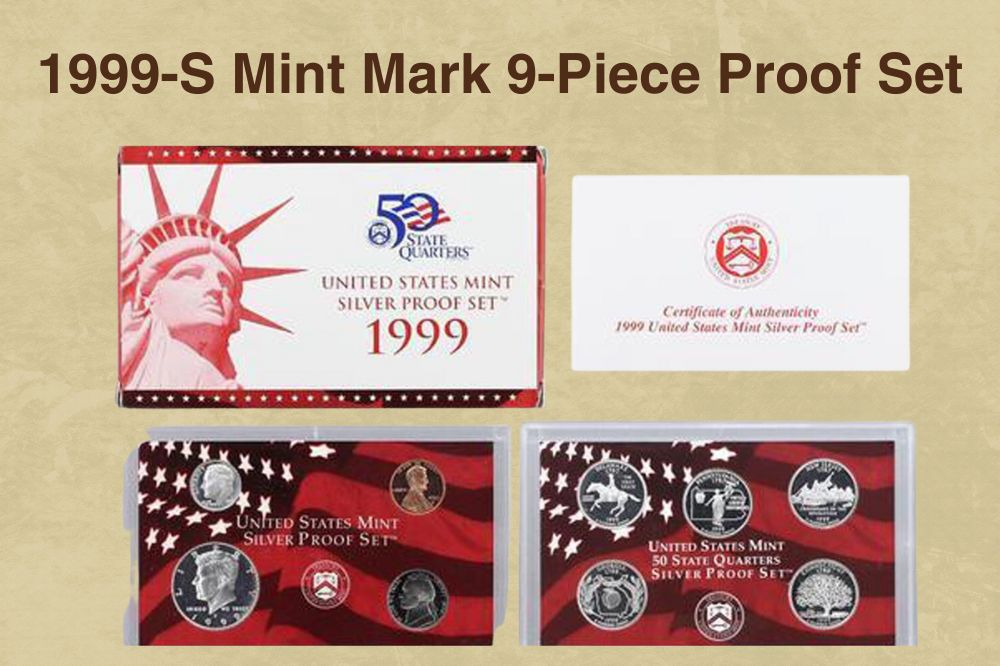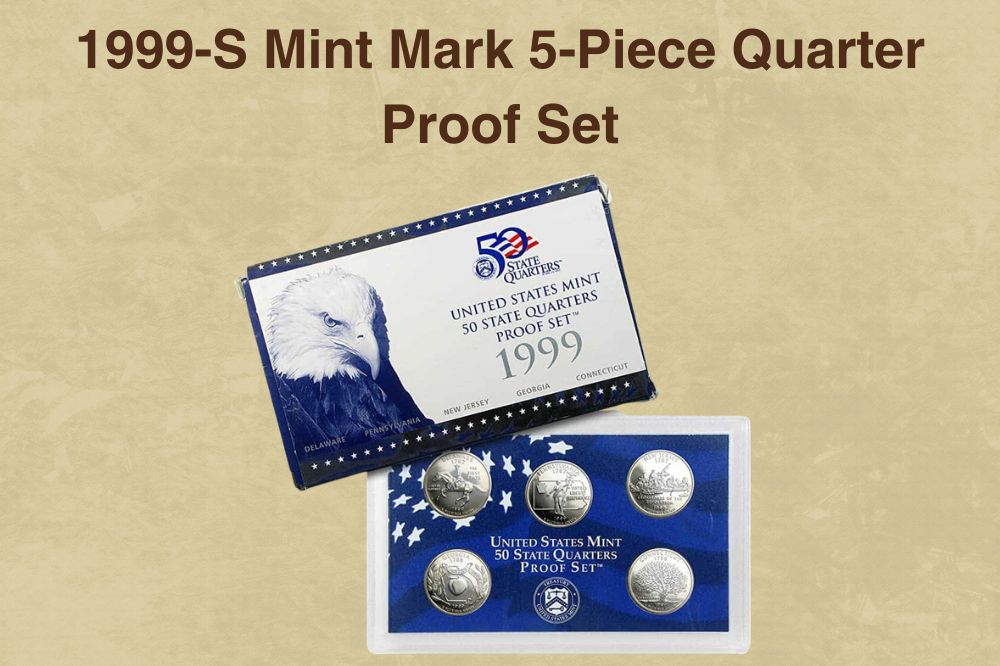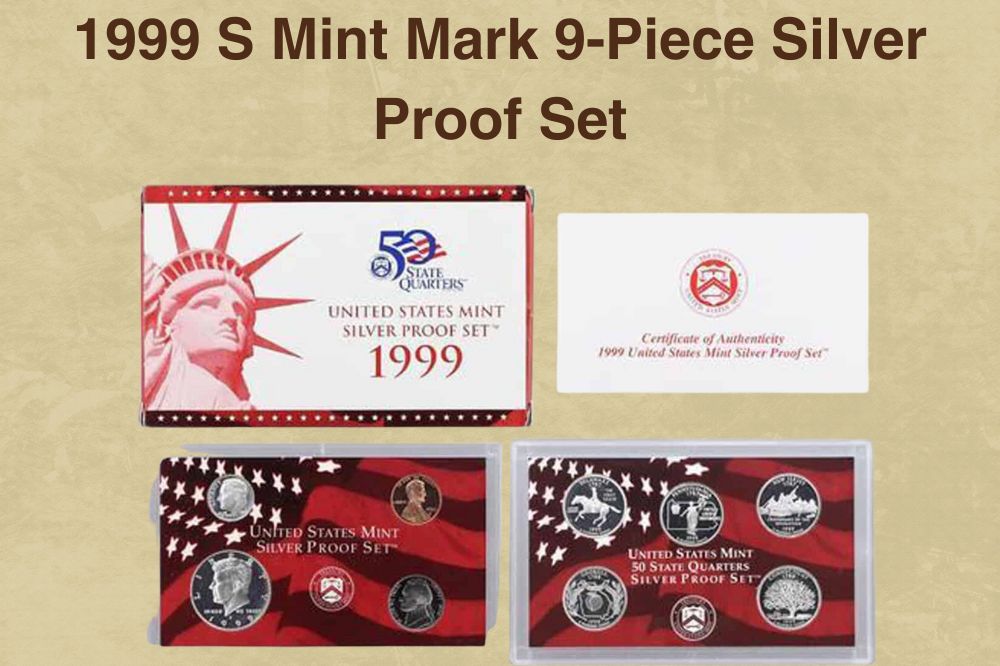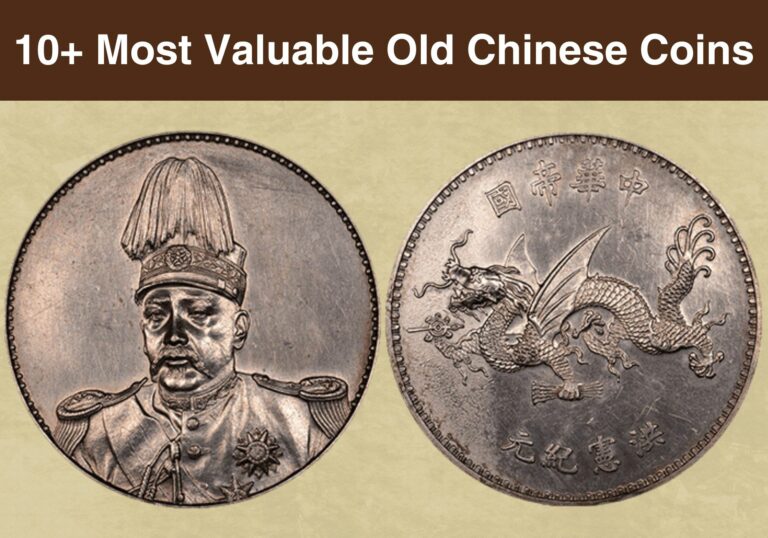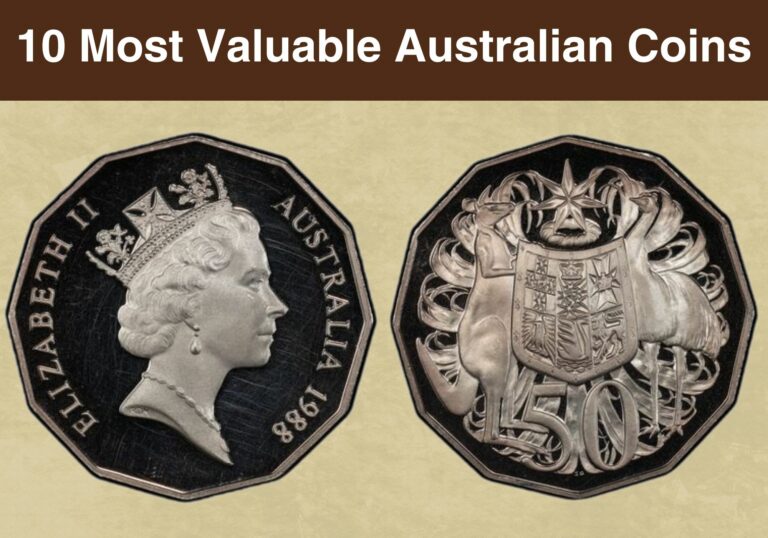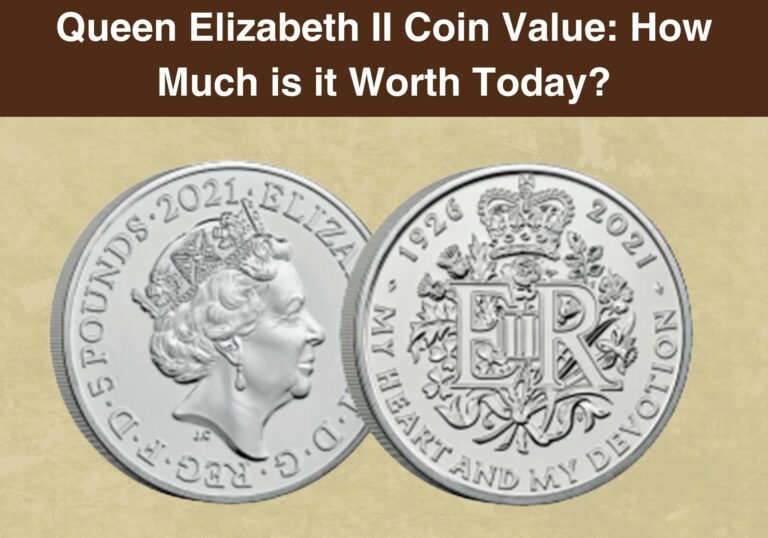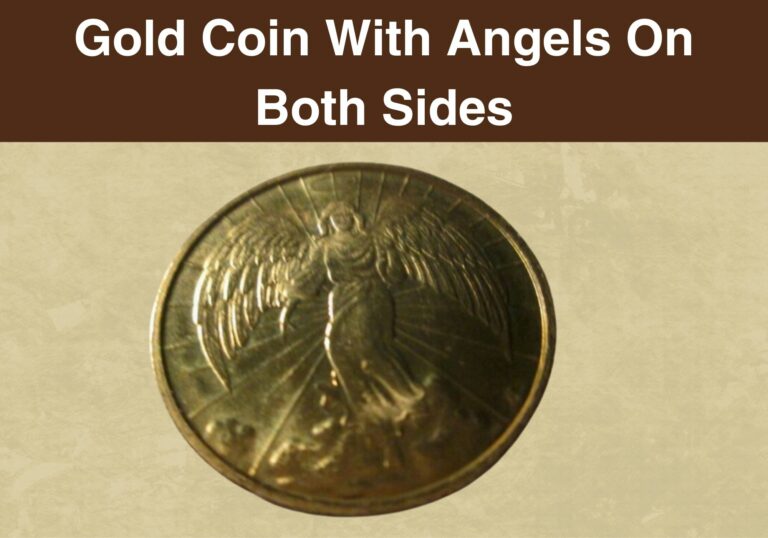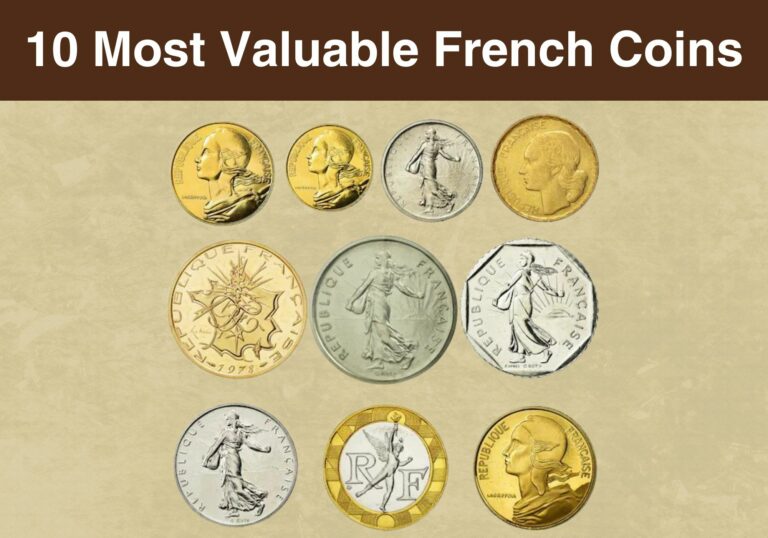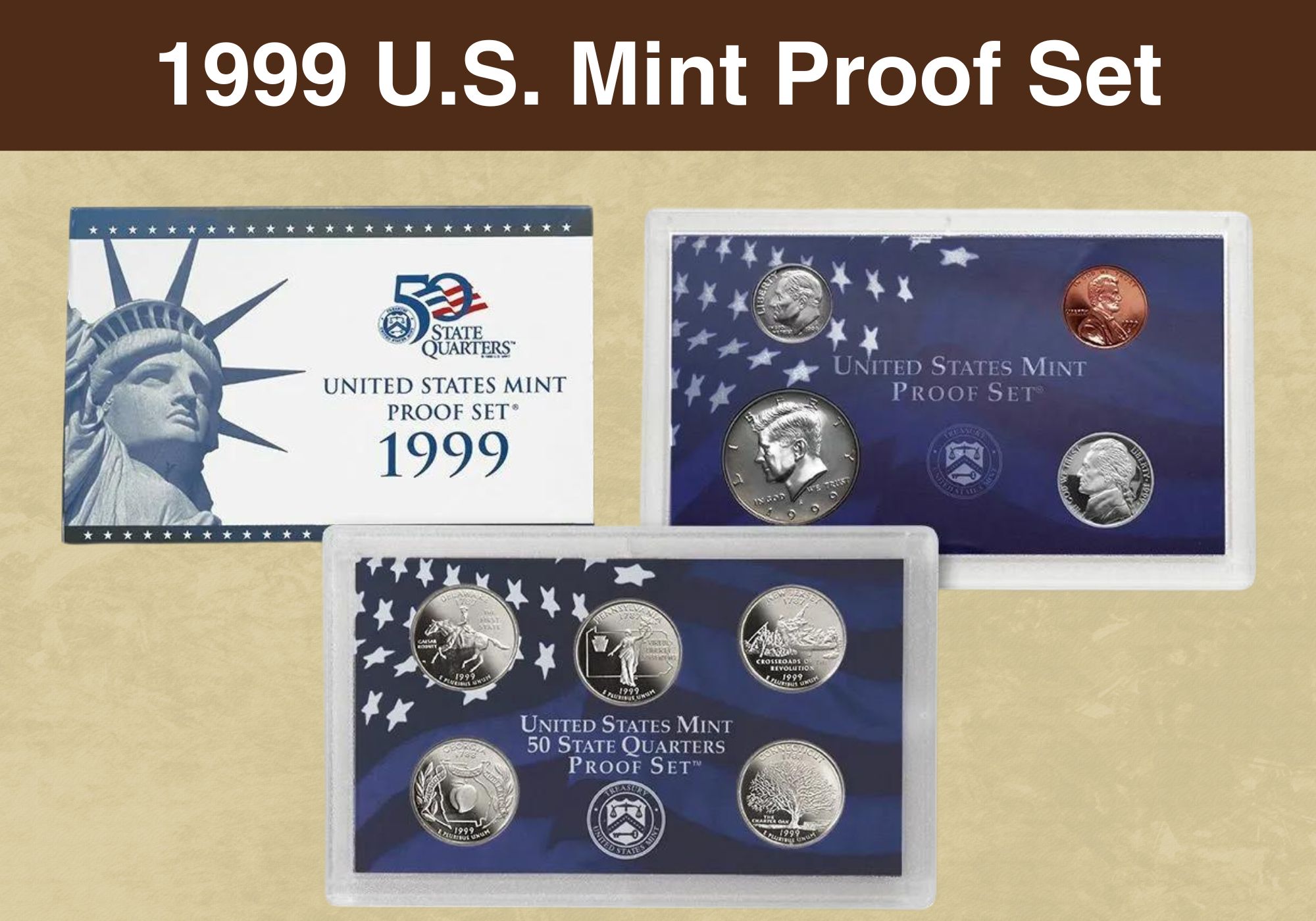
Coin Value Contents Table
The popularity of U.S. mint Proof set coins has continued to rise steadily, especially among new collectors. This is majorly because they allow collectors to collect valuable coins in a single purchase.
Although each proof set represents a celebration in history, Proof sets from 1999 are sought after as they consist of five coins from the 50 State Quarters Program.
We’ve packed this post with relevant information for collectors and enthusiasts interested in learning about this unique coin collection. Here, We’ll explore the 1999 U.S. Mint Proof Set Value, revealing notable facts in its history, variety, grading, and errors.
1999 U.S. Mint Proof Set Value Chart |
|
| Mint Mark | Proof |
| 1999-S U.S. Mint Proof Set | $12 |
| 1999-S U.S. Mint Quarter Proof Set | $6 |
| 1999-S U.S. Mint Silver Proof Set | $90 |
1999-S Mint Mark 9-Piece Proof Set Value
A quick peek into the 1999-S mint mark U.S. mint proof set, and you’ll find nine distinct coins. The collection comprises five quarters of the 50 State Quarters Program and four presidential coins, all in different denominations.
Coins in this Proof set possessed the S mint mark, a telltale that the San Francisco Mint produced them. The total mintage of this coin is 2,543,401 pieces, making it the highest quantity proof set produced in 1999.
In addition to this, you will be interested in knowing that this proof set was the first to come in two separate cases. One of the cases contained the four presidential coins, and the other housed the five State quarters for the year.
History
It all began early in the 19th century when the U.S. Mint began producing mint coins. These coins were tagged special, and their minting required greater attention to detail than regular ones.
Although the U.S. Mints initially only made proof versions of a few selected coins to serve as a collector’s item and not for commercial purposes, as proof coins became popular, collectors began demanding proofs of each previously struck coin.
In response to this request, the U.S. Mint made proof coin sets (the penny, nickel, quarter, Half dollar, and one dollar). Each coin set was sealed in a clear plastic case, packaged, and sold only to collectors.
At the turn of 1999, the U.S. Mint launched the 50 States Quarters, a program designed to include additional five new quarters to the Proof set each year. The program was slated to run for ten years, and five different Quarters would be included each year, representing each of the American States in the order they joined the Union.
With this move announced, many collectors couldn’t wait to get their hands on one, and when the set was finally released, the U.S. Mint recorded an impressive profit compared to the previous year, with over 2.5 million dollars in sales.
This was shocking because the set sold at nearly double the price of the previous ones due to the addition of the five new quarters (Connecticut quarter, New Jersey quarter, Georgia quarter, Pennsylvania quarter, and Delaware quarter).
In May 2002, the mint decided to sell off some unsold proof sets it had in storage; this included the 1999 Proof set. These sets sold for an initial price of $94.95, and Collectors could buy as much as they wanted as individual orders were not restricted to any specified amount. However, the total number of orders could not exceed the available quantity of 150,000.
As time passed, an announcement from the U.S. Mint halted the sales of the Proof sets not too long after production began due to damage from storing the coins.
The Obverse
The obverse of the four presidential coins in the 1999 U.S. mint Proof set features relief portraits of some of the nation’s past presidents.
On the Lincoln Cent, you’ll find a right-facing bust of Abraham Lincoln taking up the cent’s center. “IN GOD WE TRUST” is written curvedly above his head, close to the coin’s rim, while “LIBERTY” appears on the left, near the back of his neck.
On the Jefferson Nickel, Thomas Jefferson’s close-up profile faces the left direction. Next to it is the phrase, “IN GOD WE TRUST,” which you can spot near the coin’s left rim.
Franklin Roosevelt’s head also appears facing left on the Roosevelt dime. Next to it is the boldly written “LIBERTY” inscription, which is seen on the coin’s left rim.
The last former president featured in this set is John F. Kennedy. On the obverse of the Kennedy half dollar Proof coin, his portrait occupies the center. Also, on close examination, you would observe that the top of his head touching the “BER” in the spaced-out “LIBERTY” curved along the coin’s top half rim.
Finally, beside his neck, you’ll notice the words “IN GOD” and “WE TRUST”, with the former on the left and the latter on the right.
The Reverse
On the reverse of each quarter coin in the 1999 U.S. Mint proof set, you can see unique elements that symbolize one of the first five states in the Union.
For instance, On the Delaware Quarter, there’s an image of Caesar Rodney riding a horse, indicating his journey to Philadelphia in 1776. This journey is particularly important because of its purpose, which was to sign the Declaration of Independence
The Pennsylvania Quarter is even more appealing because it features a striking image of the Commonwealth statue located at the state’s Capitol dome. It also features what looks like the state’s outline behind the statue.
Moving further, another interesting feature is the 1776 depiction of George Washington crossing the Delaware River with his troops, this t the center of the New Jersey Quarter’s reverse.
The Georgia Quarter’s more simplistic reverse design features the Peach, the state’s symbol, and its motto and state outline. Finally, the Connecticut Quarter dedicates its reverse to the Charter Oak located in the state, symbolizing the country’s independence.
The Edges
In the 1999 U.S. mint Proof set, only the Lincoln Cent and Jefferson Nickel have plain edges. All the others, including the five new quarters and two presidential coins, have reeded edges.
Details
The five quarters in this Proof set are made of 75% copper and 25% nickel bonded to a 100% copper core; they weigh 2.27 grams and have a diameter of 17.9mm. The details of presidential coins vary, however.
For one, the Roosevelt dime and Kennedy half dollar comprise copper and nickel in similar amounts as the quarters. They weigh 2.27 grams and 11.34 grams, respectively.
The Lincoln Cent is the only coin having zinc metal in its composition. It’s also the lightest presidential coin in the set, weighing 2.4 grams and 19.05mm in diameter. The Jefferson nickel is a slightly heavier coin weighing 5 grams. It has a diameter of 21.2mm and is composed of 75% copper and 15% nickel.
Value
The S mint mark 9-piece Proof set has a value that fluctuates depending on market conditions. It is currently worth $12 and has maintained this value since February 1, 2021, when it rose from $8.
1999-S Mint Mark 5-Piece Quarter Proof Set Value
The 1999 S mint mark 5-piece quarter Proof set contains only the first five quarter coins for the year. The coins bear the “S” mint mark to indicate they were minted at the San Francisco Mint. Also, with a total mintage of 1,169,958, this proof set has the second-highest quantity among the three proof sets of 1999.
Value
The 5-piece quarter Proof set is the least favorable of the three set types among collectors, with a slightly lesser value than the 9-piece set earlier discussed. However, according to the current market price, it is worth $6, almost five times its face value of $1.25. It returned to this price on February 1, 2021, after an initial drop to $5 in December 2019.
1999 S Mint Mark 9-Piece Silver Proof Set Value
Although coins in all the 1999 proof set types have a cameo or deep cameo finish that many collectors find appealing, collectors consider the silver proof set more valuable. The 1999 silver proof set was so widely accepted that it sold about 804,565 pieces, a notable increase from the previous year.
Value
As collectors’ interest in the State Quarters grew, the demand for the silver proof set increased way more than the quantity available.
This increase caused a significant spike in the market value of the 1999 silver proof set. As a result, it ranks the highest in terms of value among the three set types, with a current market price of $90. A quick look at the coin chart history shows that it rose to $110 in 2021.
1999 U.S. Mint Proof Set Grading
Proof coins usually come in higher grades because they have not gone through many hands over the years, unlike regular coins used for commercial purposes. Therefore, each coin in the 1999 proof set is graded between 60 to 70 on the coin grading scale.
This video shows how the proof coins are graded according to PCGS.
Rare 1999 U.S. Mint Proof Set Error Lists
An error coin has visible dents or markings resulting from a poorly-executed striking process. Although proof sets consisting of only flawed coins are impossible to find, finding one quarter, cent, or nickel with an error is possible.
Let’s look at some possible errors contained in the 1999 proof set.
1999 U.S. Mint Proof Set Die Crack Error
A coin die is a tool used to impress designs onto blank coins. Typically, this tool strikes several thousand coins before becoming too worn out. Through regular use, the dies leave visible jagged line markings and cracks on the coin’s obverse or reverse.
The value of coins in the 1999 proof set having the die crack error will increase depending on the size and position of the crack. However, because proof coins are minted with more care and precision, cracks will often appear faint and sometimes unnoticeable to the naked eye.
1999 U.S. Mint Proof Set Strike-Through Error
A strike-through error is one fascinating error that commands a high price in the coin market. It occurs when a foreign object sticks to the die immediately before striking the coin, resulting in a raised or indented spot on its surface. The strike-through error can appear on any 1999-proof coin, but a known occurrence was on a Connecticut silver quarter.
A flawless 1999 U.S. Mint Silver proof quarter in excellent condition, especially one with the highest grade a proof coin can receive: a PF70, will sell for about $45. On the other hand, you can find one with a strike-through error at a much higher price due to its rarity.
A tiny error might only add a few dollars to its value, while if the error is apparent, it could increase the coin’s value by hundreds or a few thousand dollars.
1999 U.S. Mint Proof Set Close “AM” Error
You’ll find the close AM error on the reverse of a few 1999-proof pennies. It occurs when a proof die specially made for close-collar striking is mistakenly used to produce a penny. This error makes coins marked with it highly desirable by collectors.
You can spot coins having this error by looking at the first two letters, “AM”, in the word “AMERICA ”. Usually, they’ll appear too close to each other, unlike error-free coins with relatively wider spacing between their “AM”. In terms of value, coins with this error are worth significantly more than those without it.
A 1999 close “AM” proof penny has a current market price of over $200, a great value when compared to error-free ones that are only worth $5.
1999 U.S. Mint Proof Set FAQs
How Can I Tell If a 1999 U.S. Mint Proof Set is Fake?
You can start by looking at its packaging. The 1999 U.S. Mint proof set comes in a cardstock box containing two cases. For the regular 9-piece Proof set, inspect each case to be sure it has blue inserts, while for the silver proof set, confirm that the case containing the presidential coins has a red insert.
Also, remember that an original 1999 U.S. Mint proof set comes with a Certificate of Authenticity. You can find this vital piece of paper inside the box. Finally, we advise you to purchase your Proof set from credible online and local coin vendors to reduce your chances of getting fake ones.
How Much Silver is in a 1999 Silver Proof Set?
Coins in the 1999 silver proof set have a 90% silver content with a total silver weight of 1.33826 ounces. This high content can fetch you good money if you’re going by the current silver spot price of $25.16 per ounce.
When Can I Get More Info About The 1999 U.S. Mint Proof Set?
You can browse the U.S. Mint’s official website to learn more about the 1999 U.S. Mint proof set. Additionally, you’ll learn about the history, value, and varieties of the Proof set on the online platforms of some authorized coin services, such as the Professional Coin Grading Service (PCGS) and the Numismatic Guarantee Company (NGC).

